Alchemical Frames
I’m writing at the end of the era of cinema as we’ve known it, the beginning of an era of image-exchange... 1
--Gene Youngblood, Expanded Cinema, 1970
My work on Salt and Glue pointed me in a number of directions simultaneously. In my studio, I began to notice the ways in which specific technologies affected image and spatial types, inspired their mutation and transformation, and implied various input and output strategies. In order to navigate and exploit these relationships, I moved my work consistently between analog and digital, still and kinetic modes. I also began to dig through the history of abstract and cameraless filmmaking and discovered not only the myriad elements of this history (images, techniques, filmmakers) but indications of a marked revival of interest in it.
That this revival is occurring now is not, I think, a coincidence. The historical and contemporary worlds of abstract filmmaking share a preoccupation with synaesthetic techniques and methodologies. Whereas filmmakers like Hans Richter and Oskar Fischinger were working through the problems of translation between drawing, painting, film, and music, contemporary abstract filmmakers have this palette and all of its digital counterparts with which to contend. Many of the questions being asked in the forty year intervals where this interdisciplinary creative process seems to most strongly affect the content and construction of moving images (1920’s, 1960’s, 2000’s) are similar, though the means of answering them are specific to each generation’s toolsets and ideologies.
Contemporary cinema moves fluidly between analog and digital worlds, importing and exporting content of both varieties. While there has been much written about cinematic content and composition, not enough has been written about how both are being affected by technologies that are changing the very components of cinema and the means of identifying, ordering and presenting them.
The relationships between film and video, between still and moving images, cinema and cinematic performance have become increasingly volatile in the midst of all this analog-digital exchange. Film can be digitized and video can be printed. Treated film that cannot be projected (for fear it would blow up a projector) can be digitized or printed to film frame by frame. Digital video cameras allow for still image shots, film frames translate into still images. Some digital cameras intended for still photography can store small amounts of video footage. Still images (from film, video, and still cameras [analog or digital]) can be the basis for or parts of a cinematic composition, as can digital images scanned into or created directly on the computer. A vast array of software packages intended for an equally vast set of purposes can generate moving images in multiple and mutable formats. Virtual models and bodies can be animated, algorithms and scripts can drive graphic mutations, sounds can generate motion graphics. The complexity of the field only increases when the possibilities for output are considered alongside those for input. Interactive performance and installation environments can simultaneously utilize and produce image sequences. Cinematic exhibition exploits sites other than the screen: the moving image can complete a canvas, impact a photosensitive surface, define a body, illuminate an object, produce a musical composition, map a dance. Any of these incarnations can be incorporated into another cinematic event, conflating output and input. Cinema and its imagery are now something to be represented rather than a mode of representation. The nature of contemporary cinematic production includes the possibility that cinema is continuously a component of itself.
For practitioner and audience alike, engagement with such an extensive range of cinematic possibilities is daunting and the rules of engagement are elusive. Nelson Goodman once asked these questions, relevant here: "With all this freedom to divide and combine, emphasize, order, delete, fill in and fill out, and even distort, what are the objectives and the constraints? What are the criteria for success in making a world?"3
Goodman’s conception of “world” is far reaching, but it can be understood to include any work that results because (or in spite of) the combinations, permutations and transfers involved in its construction and reception. Goodman invokes the figure of the scientist to answer his questions, someone who “…as much decrees as discovers the laws he sets forth, as much designs as discerns the patterns he delineates.”4 But what kind of figure presides over the contemporary cinematic field? What are the laws, the patterns to be discerned and delineated there?
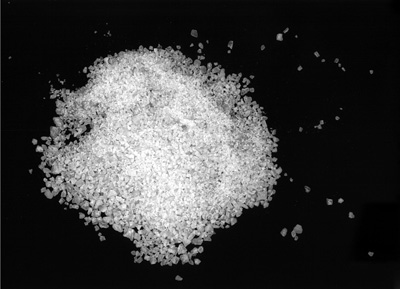
It seemed to me at first that what I had come up against was a frame problem. On the one hand I had a long, plasticized strip, divided into frames, dusted with salt in such a way that the frames and their originary function were obscured. Had this strip been projectable, it would have run through a projector at the rate of 24 frames per second | 1.5 feet per second. Because it wasn’t, I digitized it (using an old Steenbeck that gave it the strange appearance of being coated in vaseline.) It became one digital element among many, driven by whatever initial rhythm the Steenbeck and I had contributed in tandem. On the other hand I had a digital still image of a certain size and resolution. Once imported into a video editing environment, it did not have frames, but it could stand in for one or many. It was framed (circumscribed by its given borders), but it could be reframed in any number of ways. It could be manipulated to give the appearance of movement; its color, shape, opacity and a whole host of other characteristics could be re-cast; it could be assigned any duration. As I began to edit, cutting, combining, compositing, there were immediately too many options. Nelson Goodman’s questions remained. What criteria was I using, and in what world or worlds did they originate? I drafted some notes about the frame as a first way in.
To frame something is to set it apart from the rest of the world. The act of framing is one of naming, of designation.
There are so many kinds of frames. There are building frames, support structures hidden under layers of material but sometimes exposed for architectonic effect. There are structures that surround or enclose particular spaces, boundaries like walls and fences and hedgerows. There are containers, racks for hay and livestock fodder, triangular forms for grouping pool balls, cold frames (greenhouses) for protecting seedlings and plants from cold weather. There are decorative borders in fringe and haircuts and picture-frames. There are bodies and frame types, ectomorphs, mesomorphs, endomorphs. There are compositions and outlines for written and spoken language. There are online frames: does your browser support them?
One can frame a phrase by mouthing it silently, frame a constitution by drafting it, frame someone up by making guilt out of innocence, frame a contest by arranging its result in advance. One can have a particular frame of mind or use a particular frame of reference. One can be at an advantage or disadvantage in the midst of a framework, knowledgeable about context and method or unsure of where to place the next nail. One can frame a story by positioning individual pictures in an extended narrative, one can tell a frame-story that contains and connects all other stories.
Coming to a frame causes a stop. Attention stretches at the appearance of a frame-site. Difference is indicated: here is not there, this is not that, you are not me. Working inside the frame is not the same as thinking outside the box. Looking out from within is not the same as looking in from without.
_______________________________________________________________________________________________________________________
Working with Salt and Glue had revealed a site that was framed, and a site that contained many frames. The resistance I met had something to do with a lack of awareness of and attention to the characteristics of the site-frame, and the site-frames. Salt and Glue was a video. I had to figure out what that meant, really. It would have an overall architecture, support structures and boundaries. It would contain variables, and they would have relationships. It might have theoretical and decorative and other components named to describe their role in the work. It would have silence and sound, direction, moments of truth and falsity (the real vs. the retouched). Its whole would refer to how it was framed, and its parts would occupy frames. There would be meaning, and there would be moments of meaning.
Our pictures of the world are increasingly cinematic, and the sites of cinema include the frame. Yet the filmic frame is no longer what it used to be. Once a locatable and viewable segment of the cinematic enterprise, the frame has shifted territories and changed character in the process. Digital technologies have altered the definition and boundaries of the frame: in this new landscape the frame acts, strangely but definitively, uncinematic. The digital frame is a unit of time rather than a unit-image in time. It stands in for its predecessor as a representation, acting much like the molded plastic stitching of a dashboard that recalls the days of leather and thread. The digital frame does not hold an image like the filmic one does; it is a multidimensional space for image information and treatment that can increase in density on the x, y, and z axes, and past them, too.


Making the image portion of a digital video involves assembling content from the reference library in the video channels. This content appears in sets that occupy a certain amount of time on the timeline—each set appears as a rectangular block, the content of which is known by its name and sometimes, a small image that is a reference for its content. A set can contain most anything--video, animation, image, text. Through the use of video effects and filters, sets can be manipulated--moving images stilled, still images moved, duration and speed changed. Content too can be altered: rotated, scaled, colored, blurred, sharpened, textured, masked. Content constructed in the timelines can also be added to the library, making the acts of image gathering and editing concurrent. In the digital arena, the set has stepped into the space previously occupied by the frame. The frame, however, remains a shadow reference by which to calibrate its comings and goings.
The structure of film and the structuration of its frames were primary subjects in two books by the Soviet director Sergei Eisenstein—Film Form and The Film Sense. Eisenstein developed and extensively studied montage, a process of assembling, juxtaposing, overlaying and overlapping images over time. He treated montage not merely as a series of visual techniques but as a methodology that conveyed meaning beyond that given by filmed content. Eisenstein described five formal categories of montage: metric, rhythmic, tonal, overtonal and intellectual.8 These montage types were guided by different rules of construction and assorted treatments of the part-whole relationship; many of them functioned according to musical principles.
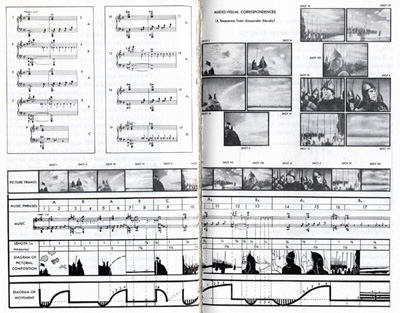
Eisenstein’s compositional methods do not translate easily to the digital editing environment. There, the timeline is the baseline, the placement of a set on the timeline the means of keeping track of it. Sets do not divulge their content the way that frames do, they do not say, because of what they are, where they are or what content they actually possess. To know what a set is and what treatments it has received requires a stellar memory, detective work or a map. Double-clicking on a set may clarify what motion or video effects have been applied to it. But when a set is layered with other sets, and those sets have their own treatments, the density of information increases and it becomes difficult to keep track of what one set is doing alone or relative to other sets. It is possible to align visual and musical events, to create correspondences between them. And the interplay of various sets can be viewed by moving through the timeline, slowly or in real time. But such alignments and interplays are established from a posture of reception, a decidedly post-structuralist position from which to create meaning. This position opposes structuralist practices that utilize compositional diagrams to drive the construction and shape of the work.
In the digital timeline there is always something underneath peering through, hidden instructions underwriting the lives of images and sounds, incantations and gestures that overlay the act of construction. The sets speak only when you go into them, and even then, they speak in tongues. Names and representations and histograms: in the midst of such anonymous cinematic density, there is a call for recipes of an alchemical nature.
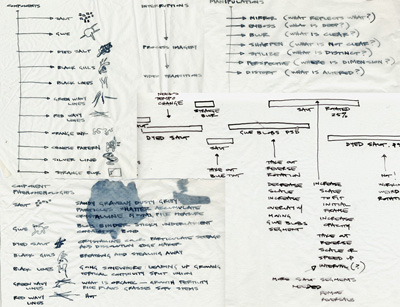
I made a list, and wrote:
salt: sandy, gravelly, dusty, gritty, particles, shatter, accumulate, mound, pile, measure
glue: blob, binder, sticky, underlayment, connector
dyed salt: crystalline color, particulate seepage, dissolution edge
black gills: breathing and stealing away
black lines: going, leading up, growing vertical, continuity, split, union
I wrote about some of the filters:
mirror (what reflects what?)
emboss (what is deep?)
blur (what is clear?)
sharpen (what is not clear?)
stylize (what is distinct?)
perspective (where is dimension?)
distort (what is changed?)
I wrote some phrases about morphing and interaction:
the salt is in the glue
the glue holds down the salt
the salt dissolves in the glue
glue-land
salt-city
I drew an analog timeline, and made notations:
take out blue tint here
needs salt beat
decrease scale increase overlay
more speed changes
use repeatedly
I was reading about alchemy at the time, and had a book nearby with a glossary of alchemical terms at the back. The entry for salt read: “common salt; [Albertus Magnus] said it was the key to the art, opens and closes all things and no alchemical work can be completed without it.”10 The alchemical description of salt designated its function and placed it in an elemental hierarchy: it signified beginnings and endings, entrances and exits, and it was essential. I expanded on the alchemical given. For Salt and Glue, salt would be both solid and ethereal. It would create friction and it would be a veiling dust, something that resisted and obscured but could be cleared away.
As I was reading the alchemical entry about salt, I remembered two diagrams in the same book. The first showed the golden chain of the elements (the catena aurea) and the links between them 11:
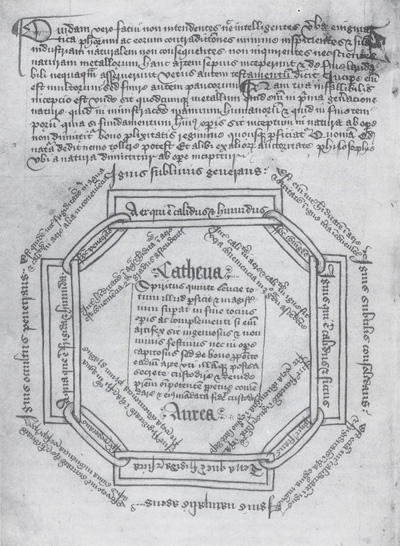
By permission of The British Library
ADD.11388 f9
The second image was an astrological-alchemical diagram made by Francis Thynne in 1574 13:
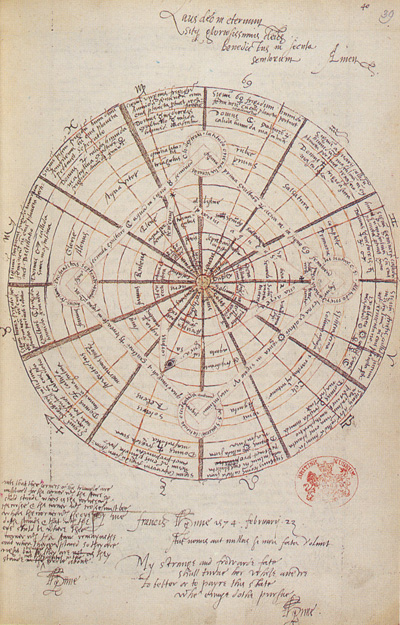
By permission of The British Library
Sloane.2476 f10v
I had found a language by proximity, and I had somehow circled back to Nelson Goodman, for he also wrote "worlds are made not only by what is said literally but also by what is said metaphorically, and not only by what is said either literally or metaphorically but also by what is exemplified and expressed—by what is shown as well as by what is said."14
The resistance I perceived between the strip and the still was a resistance born in the worlds they occupy and the languages they inhabit. Bringing them together was a synesthetic act that invited metonymic and metaphorical inquiry and the construction of a system for naming, assembling and exhibiting their component parts. In the making of Salt and Glue the digital set revealed itself, as the filmic frame once did, as a site of and for transformation. As a result, the video site disclosed the potential for the allegorical chemistry, a new alchemy, in its timeline.15
1. Gene Youngblood, Expanded Cinema (New York: EP Dutton and Co., 1970), 49.
2. Salt and Glue was completed in 2002 and is part of a group of works called The Alchemy Series. It is an exploration of the poetic and formal relationships of salt and glue. A compressed version of the video is available at:
http://www.cm.aces.utexas.edu/faculty/skrukowski/studiopages/filmwork/film.html
Salt and Glue has screened internationally; the sound score was composed by Daniel Nass.
3. Nelson Goodman, Ways of Worldmaking (Indianapolis: Hackett Publishing Company, 1978), 17.
4. Ibid., 18.
5. I have since named this phenomenon the resistance of the medium and will dedicate a subsequent article to its investigation.
6. I was unable to secure permission to reproduce an image of Irwin’s work for this article. Jon Mason at Pace Wildenstein, New York was kind enough to forward an image of the work, but the Artists Rights Society, New York, which represents the Irwin estate, refused to grant more than a five year copyright permission for an online journal.
7. Lawrence Weschler, Seeing is Forgetting the Name of the Thing One Sees: A Life of Contemporary Artist Robert Irwin (Berkeley: University of California Press, 1982), 183.
8. Sergei Eisenstein, Film Form (Orlando: Harcourt Brace and Company, 1949), 72-83.
9. According to the Russian Archives Online Project in Moscow, this image is free for publication. Apparently the copyright for all materials connected with the film "Alexander Nevsky" belongs to the production studio. According to Russian laws the copyright period is 50 years, so the diagram is free for publication since the film was produced in 1941.
10. Gareth Roberts, The Mirror of Alchemy: Alchemical Ideas and Images in Manuscripts and Books (London: The British Library, 1994), 111.
11. Ibid., 49. Reproduced with permission of the British Library.
12. Perhaps The Alchemy Series will require a Contemporary Alchemical Glossary. Something else to write.
13. Ibid., 56. Reproduced with permission of the British Library.
14. Goodman, Ways of Worldmaking, 18.
15. In an early critique of this essay, an unnamed reviewer suggested that the points I am making are limited to avant-garde cinema production and reception. I do not agree with this suggestion. My own creative process for Salt and Glue is specific to it, but the kinds of questions I asked while making that particular piece can be easily extended beyond it. I maintain that questioning and utilizing the complexity of the technological field is important for all cinematic types, perhaps even more so for those in which the real is being identified and represented.